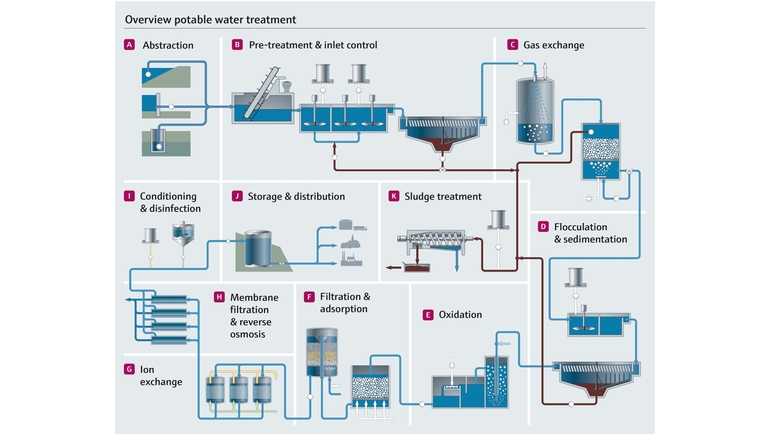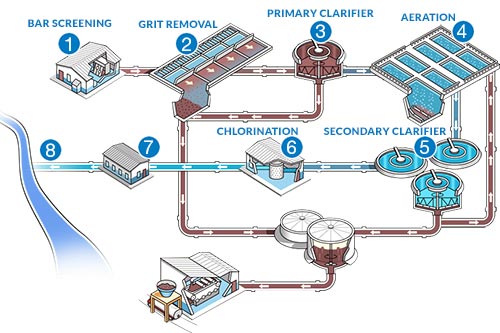An Unbiased View of House Water Treatment
Table of ContentsHouse Water Treatment - The FactsThe Single Strategy To Use For House Water TreatmentWhat Does House Water Treatment Do?House Water Treatment Things To Know Before You Get ThisHouse Water Treatment Fundamentals ExplainedThe Buzz on House Water Treatment
A phosphorous compound is added to assist manage rust of pipes. This assists stop lead and also copper that might be present in pipes from leaching right into the water. As the water leaves the plant, ammonia is included in transform the chlorine to chloramine, an anti-bacterial that preserves a recurring in the distribution system versus bacterial contamination.All chemicals that are added are certified food quality, secure for usage in foods. Treated water is stored in deep below ground containers and likewise streams by gravity to pumping stations and right into the circulation system. The circulation system includes 1,960 miles of water keys varying in diameter from 4" to 60".
Removal of taste as well as smell substances from the water.: Softens the water.: Filtration to get rid of small particles and also sanitation to kill infections and bacteria, and also make sure an inappropriate environment for infection as well as bacteria development throughout the distribution system.
Unknown Facts About House Water Treatment

According to the EPA, The Tidy Water Act (CWA) establishes the standard framework for regulating discharges of pollutants into the waters of the United States and also managing high quality standards for surface area waters. Under the CWA, EPA sets wastewater criteria for market. The EPA has actually likewise created nationwide water high quality requirements recommendations for pollutants in surface area waters.
Relevant White Documents Select Products Stage 2 Testing Elimination of grit by moving the influent over/through a grit chamber. Fine grit that discovers its way right into the influent requirements to be removed to avoid the damages of pumps and also tools downstream (or impact water flow). Also small to be evaluated out, this grit requires to be removed from the grit chamber.
House Water Treatment Fundamentals Explained
Stage 4 Oygenation Air is pumped into the aeration tank/basin to encourage conversion of NH3 to NO3 as well as give oxygen for bacteria to continue to proliferate and also expand. Once converted to NO3, the bacteria remove/strip oxygen molecules from the nitrate molecules and also the nitrogen (N) is produced as N2 (nitrogen gas) (house water treatment).
This starts in the oygenation container. The primary function of the aeration tank is to pump oxygen into the tank to encourage the failure of any kind of natural product (and also the development of the germs), along with make certain there is adequate time for the natural product to be damaged down.
This process is managed to supply the finest conditions for microbial development. Dissolved oxygen Click This Link surveillance at this phase of the plant is important. Ammonia as well as nitrate measurements are typical to determine how reliable the germs are in converting NH3 to N2.
Unknown Facts About House Water Treatment
Phase Five Second Clarifier Treated wastewater is pumped right into an additional clarifier to permit any type of staying organic debris to settle out of cured read water flow. As the influent leaves the oygenation process, it moves right into a secondary clarifier where, like the key clarifier, any kind of very small solids (or fines) sink to the bottom of the container.
Part of this triggered sludge is returned to the oygenation tank to increase the microbial focus, aid in propagation, as well as accelerate the break down of organic material. The extra is discarded. The water that moves from the secondary clarifier has actually substantially lowered organic material and also should be approaching expected effluent specifications.
With the enhanced focus of germs as component of the aeration phase, there is a requirement to check the outgoing effluent for germs existence or lack and to decontaminate the water. This makes sure that more than specified concentrations of bacteria are not launched into the atmosphere. Chlorination is the most usual and affordable sort of sanitation but ozone and also UV disinfection are also increasing in popularity.
Some Known Details About House Water Treatment

After enough time, fragments check my source abide by each various other and turn into bigger particles, or, floc, which is vulnerable to resolve in water. This process of floc formation is called flocculation. To assist in the flocculation of particles, an anionic polymer is included in the mixing zone of the cone. Explanation of water is accomplished by the seperation of suspended solids from water by gravity.
The clarified water actions upward slowly, ultimately overlooking the effluent weir to the cone electrical outlet and also on the to filters for more treatment. The water plant incorporates a solitary stage lime softening operation to eliminate solidity. Hardness is brought on by the presence of liquified bivalent as well as polyvalent steel ions, mostly calcium and magnesium. house water treatment.
How House Water Treatment can Save You Time, Stress, and Money.
This is included both in the clearwell and the high service discharge as water enters the circulation system. Hydrofluosilicic acid gives the source of fluoride, which is useful in the avoidance of dental caries in kids. A fluoride concentration of 1. 1-1. 2 mg/l is normally desirable in the plant faucet.